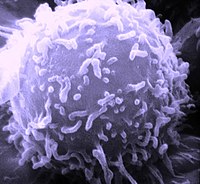
Photo from wikipedia
Background Understanding the ecological processes that are involved in the transmission of zoonotic pathogens by small mammals may aid adequate and effective management measures. Few attempts have been made to… Click to show full abstract
Background Understanding the ecological processes that are involved in the transmission of zoonotic pathogens by small mammals may aid adequate and effective management measures. Few attempts have been made to analyze the ecological aspects that influence pathogen infection in small mammals in livestock production systems. We describe the infection of small mammals with Leptospira spp., Brucella spp., Trichinella spp. and Cysticercus fasciolaris and assess the related intrinsic and extrinsic factors in livestock production systems in central Argentina at the small mammal community, population and individual levels. Methodology/Principal findings Ten pig farms and eight dairy farms were studied by removal trapping of small mammals from 2008 to 2011. Each farm was sampled seasonally over the course of one year with cage and Sherman live traps. The 505 small mammals captured (14,359 trap-nights) included three introduced murine rodents, four native rodents and two opossums. Leptospira spp., anti-Brucella spp. antibodies and Trichinella spp. were found in the three murine rodents and both opossums. Rattus norvegicus was also infected with C. fasciolaris; Akodon azarae and Oligoryzomys flavescens with Leptospira spp.; anti-Brucella spp. antibodies were found in A. azarae. Two or more pathogens occurred simultaneously on 89% of the farms, and each pathogen was found on at least 50% of the farms. Pathogen infections increased with host abundance. Infection by Leptospira spp. also increased with precipitation and during warm seasons. The occurrence of anti-Brucella spp. antibodies was higher on dairy farms and during the winter and summer. The host abundances limit values, from which farms are expected to be free of the studied pathogens, are reported. Conclusions/Significance Murine rodents maintain pathogens within farms, whereas other native species are likely dispersing pathogens among farms. Hence, we recommend preventing and controlling murines in farm dwellings and isolating farms from their surroundings to avoid contact with other wild mammals.
Journal Title: PLoS Neglected Tropical Diseases
Year Published: 2017
Link to full text (if available)
Share on Social Media: Sign Up to like & get
recommendations!